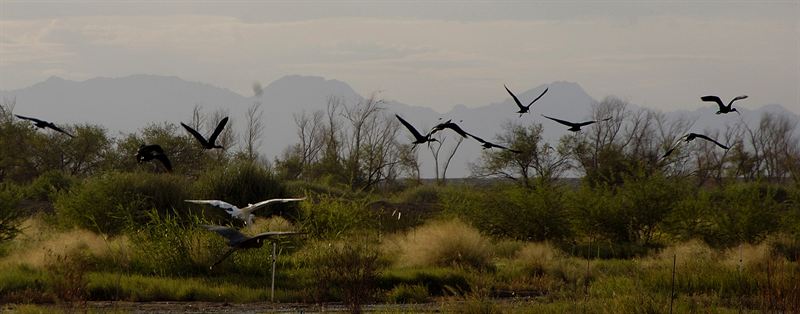Growing environmental restoration project living proof of Yuma's river renaissance

Undated - for use anytime
YUMA, ARIZONA – Nearly a century ago, this desert town became the site of the first dam on the Colorado River. That project was the first step on a path that transformed the Southwest.
But the taming of the Colorado exacted a heavy price. So it’s only fitting that Yuma is now home to one of the largest and most ambitious environmental restoration efforts in the Southwest.
Over the last six years, more than 400 acres of what was a trash-strewn jungle of non-native vegetation have been transformed into a beautiful wetlands area full of native plants, trees, bird and animals. Rustic nature trails allow residents and visitors to explore the area during daylight hours (pick up a trail guide at YVB’s Visitor Information Center at the Yuma Quartermaster Depot, or download it at www.visityuma.com).
The restoration effort has been no small undertaking: Since the project began in 2002, workers have planted more than 75,000 trees, plant and shrubs and moved more than 300,000 cubic yards of dirt to create two miles of side channel and numerous backwater lakes that now dot the once water-starved wasteland. Water used to backwash filters at the city water treatment plant now helps to flush salt from some of the poorest quality soils.
This year's initiative is a major effort to clear non-native vegetation from the banks of the main stem of the Colorado River, increasing people’s visual and physical connection to the river. Soon to be unveiled is the Quechan Indian Tribe's "Sunrise Point," a new riverfront park just east of the Ocean to Ocean Bridge with a beach, picnic ramadas, elders’ village, marshes and 35 acres of cottonwood, willow and mesquite groves.
As a yardstick for the project’s significance, consider that the best estimates put the amount of monotypic native habitat on the entire lower Colorado River in 2000 at less than 2,000 acres. So the Yuma project alone has increased that total by 20 percent.
As the tangle of invasive vegetation has been replaced with native plants and trees and water quality has improved, wildlife has voted with its wings: bird population doubled and bird diversity increased by 75 percent since the East Wetlands restoration began. In fact, rare and elusive Yuma clapper rails – an endangered species – are now mating and nesting in the East Wetlands. Diversity also increased among mammals, reptiles, amphibians and insects. When finished, this renewed landscape is expected to yield exceptional habitat for more than 330 species of birds and wildlife.
But as the restoration area opens to exploration, it’s becoming a haven for people as well as animals – a wonderful natural resource for hiking, fishing, bird watching and canoeing just steps from Yuma’s revitalized riverfront.
Throughout the project, painstaking efforts have been made to collect scientific data on all aspects of the project, so that the cutting-edge restoration techniques developed here can be applied elsewhere along the river and throughout the Southwest.
This ambitious undertaking has been possible because the Yuma Crossing National Heritage Area and the City of Yuma joined forces with private landowners and the Quechan Indian Tribe to create consensus and develop a plan. Local investment has been leveraged at a ratio of 15 to 1, with more than $10 million in grants from a variety of sources supporting the work.
To see photos and video about the project, go to www.fredphillipsconsulting.com, click on “Featured Projects” and then “Yuma East Wetlands.”
Ann Walker, 928-376-0100 (office), 928-210-9044 (cell), ann@visityuma.com
202 S. 1st Avenue, Suite 202, Yuma, Arizona 85364 / www.visityuma.com


